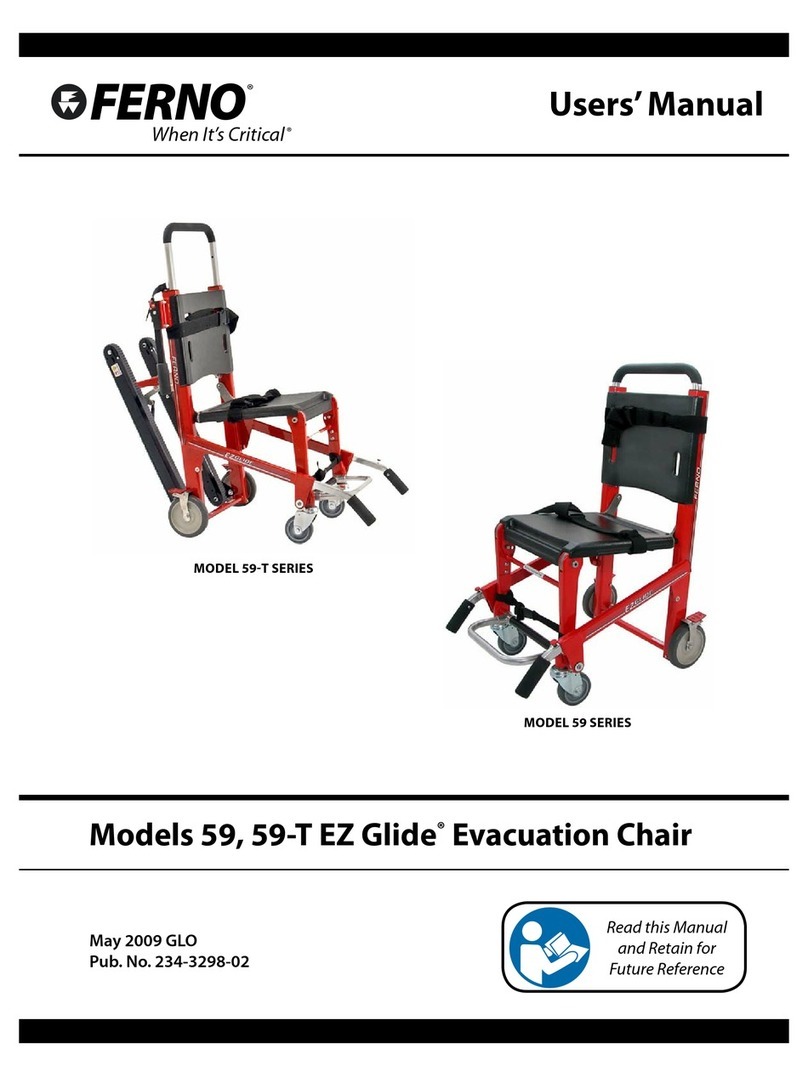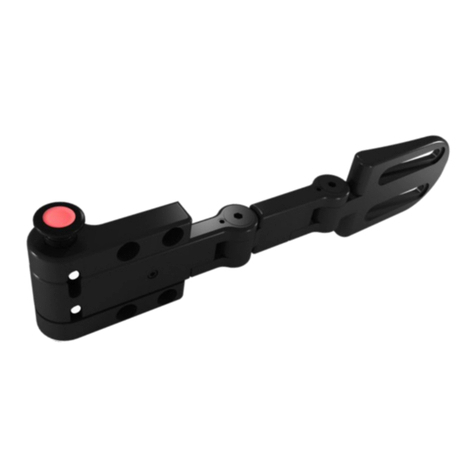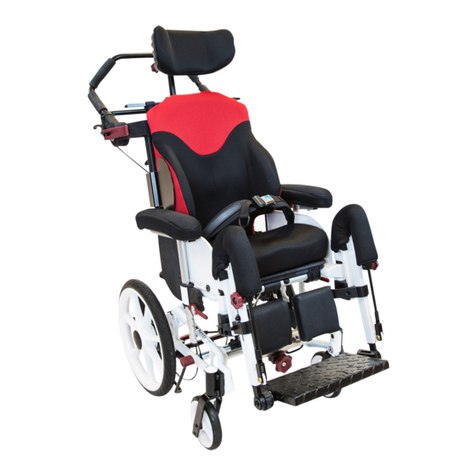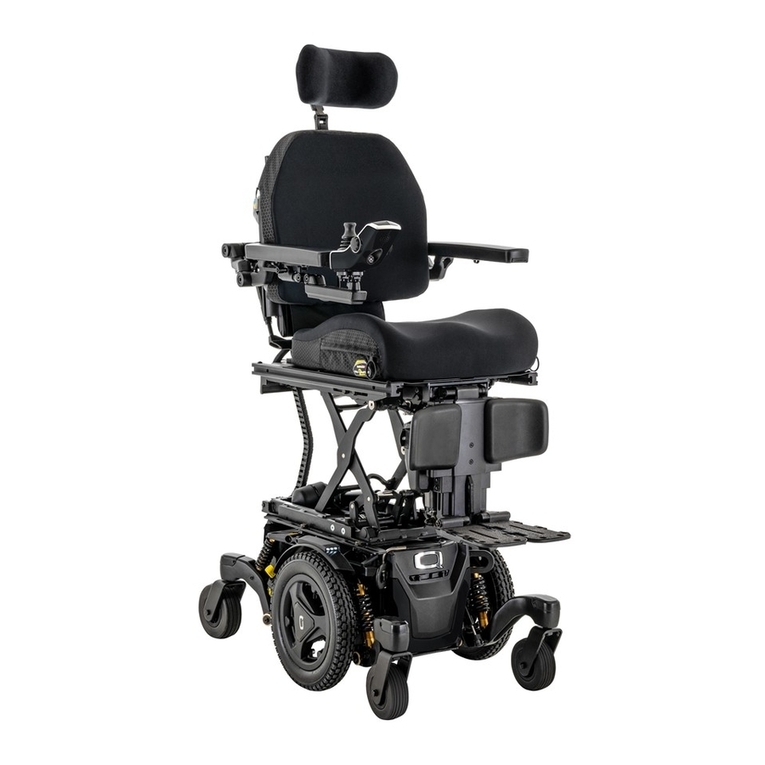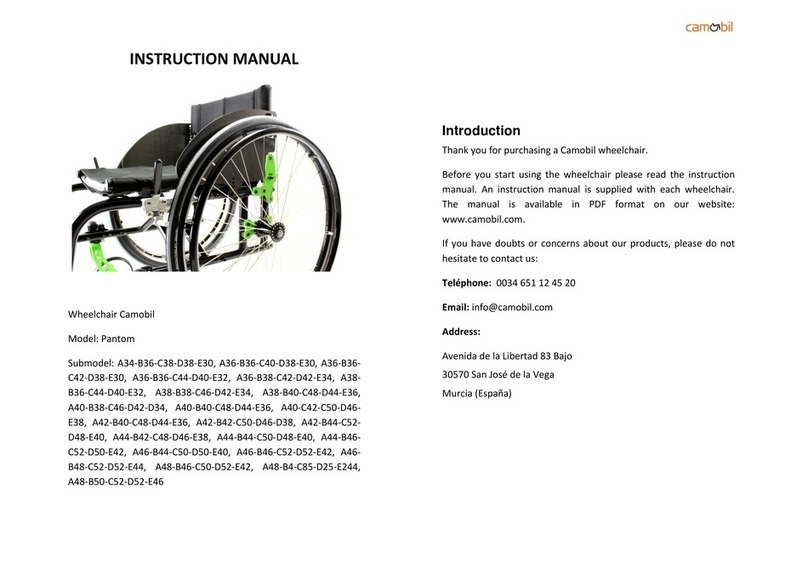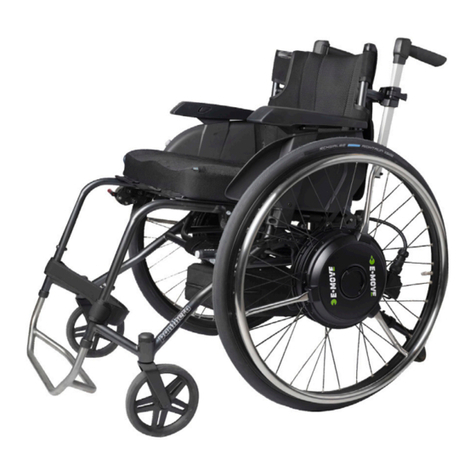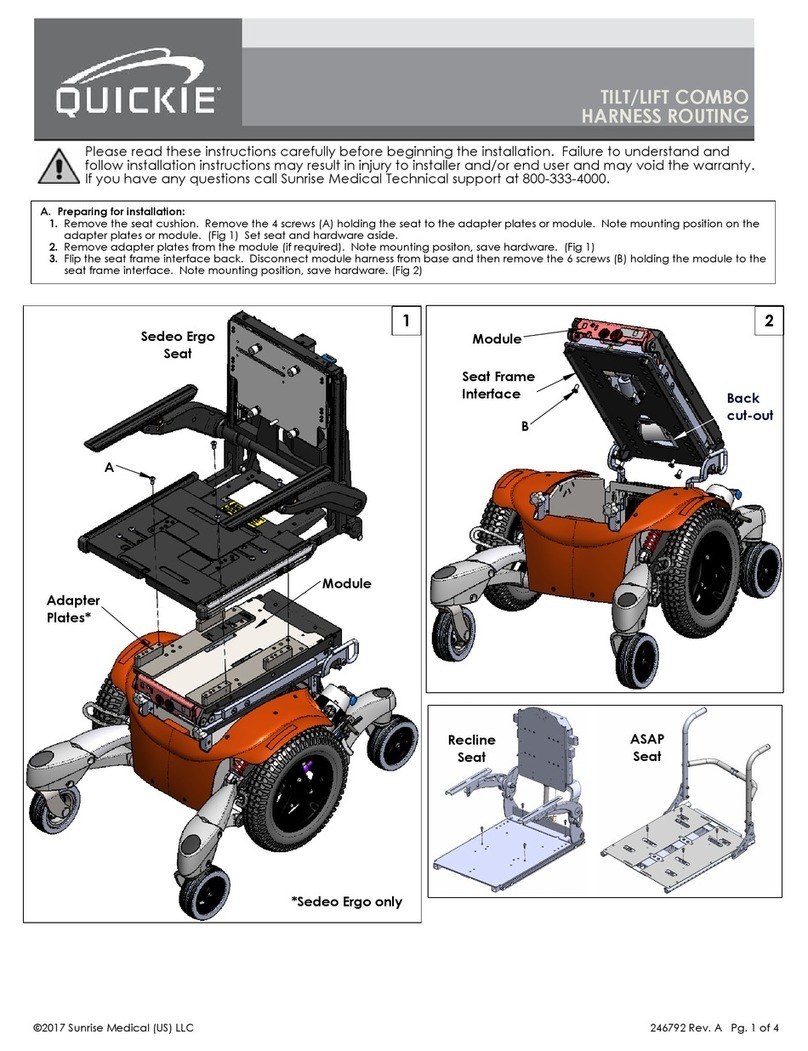Action Trackchair ST User manual

Revised ~ Nov. 3, 2016
Page | 1
Action Trackchair® Owner’s Manual
Including Models ST, NT, PT, TR, & PR

Revised Nov. 3, 2016 Page | 2
Helping the Disabled to be Enabled®
Action Manufacturing
1105 Lake Road, PO Box 620
Marshall, MN 56258
507-532-5940
www.actiontrackchair.com
Table of Contents
Forms
Triplicate Registration Form………………………………………………………………………………………………………..
Table of Contents……………………………………………………………………………………………………................................. 2
Introduction .................................................................................................................................................. 3
Safety ............................................................................................................................................................ 4
Operating the Action Trackchair................................................................................................................... 5
Comfort Adjustments.................................................................................................................................... 6
Batteries and Charging……………..……………………………………………………………………….……………………...........7 & 8
Track Adjustment for NT model……………………………………………………………………………………………………………….9
Blank Page……………………………………………………………………………………………………………………………………………. 10
Repair and Maintenance………………………………………………………………………………………………………………………. 11
Warranties .................................................................................................................................................. 12
Specifications…………………………………………………………………………………………………………………………….....13 & 14
Table 1: Hand Control Fault & Warning Indicators.............................................................................15 & 16
Strapping Methods with Trackchair Carrier................................................................................................ 17
Rocker Switch Override Instructions…………………………………………………………………………..............................18
Law, Regulation and Policy for Wheelchair/Mobility Device Use in “Federally Designated Wilderness………………….19

Revised Nov. 3, 2016 Page | 3
Introduction
Welcome to Action Trackchair. We at Action Trackchair want to make your experience the best
it can be. Enclosed in this owner’s manual you’ll find information to use and maintain your
Action Trackchair. With any questions please contact us at:
Action Manufacturing
1105 Lake Road
PO Box 620
Marshall, MN 56258
507-532-5940

Revised Nov. 3, 2016 Page | 4
Safety Guidelines
Only one person should be on the Trackchair at any time.
Seat belt is recommended.
Do not navigate Trackchair/Trackstander on more than a 20 degree slope
Trackchair will climb inclines enough to tip over in any direction.
When climbing over small logs or curbs approach incline at an angle, not directly at 90°
Make sure controls are in the off position before sitting in Trackchair and before getting out
of seat.
Always have a backup plan, “What if…?”
Do not ride the Trackchair during loading or unloading from vehicle or carrier.
Do not attempt to climb stairways.
Action Manufacturing Inc. does not recommend driving the Trackstander in the upright
position other than flat and stable terrain
Failure to know the limits can cause personal injury or equipment damage

Revised Nov. 3, 2016 Page | 5
Operating Your Action Trackchair
When you are ready to drive the Trackchair, make sure controls are in the off position
before sitting in Trackchair.
When operating your Trackchair, make sure you are securely fastened in with either the lap
belt or 4 point harness.
Your Trackchair can be programmed by your distributor/dealer to have the option of locking
the joystick or not, ask them about the availability for this option
If your Trackchair has a locking control, it can be unlocked in this way. Turn control on, hold
joystick forward until you hear a beep or three seconds, then joystick back until you hear a
beep or three seconds. It is now unlocked and ready for operation.
When locking the control, (if this option is selected by the distributor/dealer/customer) it is
done in this way. After the control has been turned off, hold the on/off button until the
control has cycled both on and then off. Control is now set in the locked mode.
The Action Trackchair control has five speeds, one-five and can be changed with the up and
down arrows.
Battery indicator is on the main screen on controls. Battery charge will last up to six hours,
depending on battery condition and type of use the Trackchair is subject to. Action
Trackchair has a built-in battery charger that plugs into 110 volt outlet.
Optional lighting is available and is controlled on the joystick control panel.
If your Trackchair has no separate Tilt–On-The-Fly rocker switch, tilting of the chair is
possible by pushing the “M” button on controls, and then moving joy stick forward or
backward to tilt chair. Cancel by pushing “M” again or moving joystick to the left.
If for some reason it is necessary to pull the Trackchair. Disengage the brakes on the motors
with the levers on back of motors. Push levers to the outsides on both motors. Do not pull
Trackchair more than 5 MPH
Action Trackchair does not recommend operating your Trackchair in the salt water,
although our Trackchairs are powder coated to the highest quality with very durable
powder coat, salt water is very corrosive and causes problems with powder coat and metal.
If your Trackchair has been exposed to salt water, rinse the Trackchair completely with fresh
water and dry off.

Revised Nov. 3, 2016 Page | 6
Comfort Adjustments
There are few adjustments that are necessary. The foot rest can be moved up or down to fit the
rider’s needs. The chair itself can be leveled to the desired comfort of the rider. The armrest
can flip down or back for easier transferring into the chair. Electronic controls can be adjusted
at a servicing distributor/dealer as far as speed, acceleration, deceleration, braking, etc.

Revised Nov. 3, 2016 Page | 7
Batteries and Charging
Battery charge will last up to six hours, depending on battery condition, temperatures and
type of use the Trackchair is subject to (terrain and weight of rider). The Trackchair has a
built-in battery charger that plugs into 110 volts.
Operation after Applying AC Power to a ProSport Charger Connected to
Discharged Batteries
During the startup test the battery type LED will be illuminated and the red charge mode LED will flash indicating that the
unit is in a self-test mode. When complete and if there are no faults, the charger's system check OK indicator will illuminate
green and the ProSport's solid red charging LED will be ON indicating the charge process is initiated. Note: If there is a fault
the appropriate bank LED will illuminate and the charge process may not start, depending on the location of the fault. See
page 25 for further troubleshooting details.
If there are no Battery Faults, the Green System Check OK LED will illuminate and the following sequences will
proceed:
The red battery type LED (factory set for standard Flooded (lead-acid)/AGM batteries) will illuminate.
The red charge mode LED will illuminate indicating the charger has started its multi-stage charging process.
When the charge process is approximately 80% complete the red charge mode indicator will turn off and the amber
conditioning LED will turn on indicating the conditioning mode.
When the multi-stage charge process is completed you will observe the following: Battery type red LED goes OFF.
The red charging LED and the amber conditioning LED will be off and the green ready/maintain LED will illuminate indicating
your batteries are fully charged.
The only LEDs on after the multi-stage charge process is completed are the green system OK LED, blue AC power LED and
the green ready/maintain LED.
Multi-Stage Charging Overview
Stage 1 - System Check OK and Battery Analyzing: During this stage the ProSport red “Charge” LED will
flash indicating ProSport is analyzing all battery connections in addition to checking each battery is capable of being
charged. Upon completion the “System Check OK” indicator will illuminate green followed by Stage 2 Charging.
Stage 2 - Charging: During this mode the “Charging” indicator will be red. The ProSport Series will use all of
its available charging amps (as controlled by temperature) until the battery voltage is raised to 14.6VDC
(Flooded lead-acid factory setting).
Stage 3 - Conditioning: During this mode the “Conditioning” status indicator will be amber. Batteries will hold
at 14.6 VDC (factory set for Flooded lead-acid batteries) to complete charging while conditioning each battery
connected. Upon completion the ProSport will go into its Energy Saver Mode.
Stage 4 - Auto Maintain (Energy Saver Mode): During this mode the blue “Power” and green “Auto Maintain”
LED's will be on indicating Stage 2 charging and Stage 3 conditioning are completed. At this time ProSport will
initiate its Auto Maintain (Energy Saver Mode) which will monitor and Auto Maintain batteries only when needed
to maintain a full state of charge.
Stage 5 - Storage Recondition Mode: During this mode the ProSport “Storage Recondition Mode” green
indicator will illuminate with a slow fade in and out pulse. This indicates that while your batteries/boat are in storage
the ProSport will automatically recondition all batteries for up to 3 hours once a month extending battery life
and maximizing on the water battery power performance.

Revised Nov. 3, 2016 Page | 8
Batteries and Charging (Continued)
To get maximum daily use, the battery must be fully charged. This is accomplished by
having the Trackchair plugged in until the “READY LIGHT” comes on.
INDEPENDENT CHARGING BANK INDICATIONS
When your battery charging system is activated, each bank provides charging information utilizing five red
Light Emitting Diode (LED) indicators and one green Light Emitting Diode (LED) indicator.
The five red LEDs enable you to track the progress of the charge cycle on each battery as the voltage rises. (see
the following chart)
The charger can be left on for an extended period of time without harming the battery.
Your system provides an equalization stage every 30 days while plugged in. If the charger is normally
disconnected from A/C after completing charge, equalization can be accomplished by plugging back into A/C
whenever this stage is desired. Battery manufacturers recommend that equalization is done once a month in
order to further reduce sulfation on the lead plates of a battery, which helps promote longer battery life. Note:
During this process the LEDs will go through their normal routine (Red counting up for % of charge) and the
Green Led will blink until the unit returns to the maintenance mode and a steady Green LED. (Not applicable to a
Gel Profile)
2 to 12.78 volts = 10%
12.79 to 13.25 volts = 10%, 30%
13.26 to 13.49 volts = 10%, 30%, 50%
13.50 to 14.04 volts = 10%, 30%, 50%, 70%
14.05 to 14.52 volts = 10%, 30%, 50%, 70%, 90% Green Flashing
{Finishing Stage} 14.52 to 15.49 volts
Dual Pro

Revised Nov. 3, 2016 Page | 9
Track Adjustment procedure for NT model Trackchairs
Track can be adjusted by loosening both bolts on the front idler wheels, inside and outside. Track
tensioners can be tightened with a 9/16 wrench by holding the lock nut and turning track tensioner bolts
clockwise an even amount. Adjustment is only needed if the track tension does not meet the below
spec. IT IS NOT NECESSARY TO OVER TIGHTEN THE TRACKS. Re-tighten front idler wheels, inside and
outside to 130 in./lbs.
Elevate Trackchair with suitable lift or blocks, here you
see the K&L model MC455 fat jack. (Purchase on-line)
Locate track lug over frame as shown
Press down on track with 10 to 15 lbs. of force and observe location
of track lug. When properly tensioned the lug at the blue arrow
should just contact the frame with 10 to 15 lbs. of force. Rotate
track to check measurement at 3 different locations around the
track to confirm measurement
Use suitable spring tension gauge purchased
from your distributor/dealer #80500

Revised Nov. 3, 2016 Page | 10
This page intentionally Blank

Revised Nov. 3, 2016 Page | 11
Repairs and Maintenance
All bearings are sealed and need no additional greasing.
Track can be adjusted by loosening both bolts on the front idler wheels, inside and outside.
Track tensioners can be tightened with a 9/16 wrench by holding the lock nut and turning
track tensioner bolts clockwise an even amount. Adjustment is only needed if the track
tension does not meet the below spec. IT IS NOT NECESSARY TO OVER TIGHTEN THE
TRACKS. Re-tighten front idler wheels, inside and outside to 130 in./lbs.
Cleaning your Trackchair/Trackstander
The Action Trackchair/Trackstander can be washed with a garden hose, do not use high
pressure wash to clean the chair. Always cover the joystick with a plastic bag to protect it
from getting moisture inside. THE JOYSTICK IS NOT WATERPROOF and should be covered
when washing, or stored outside or when transporting behind the vehicle open.
Do not spray water directly onto the motor controller under the seat.
Press down on track with 20 to 25 lbs. of force
and observe location of track lug. When properly
tensioned the lug should just contact “A" frame
at bottom right of picture with 20 to 25 Lbs. of
force. Note arrow
Rotate the track so an
internal lug is directly
above the “A” frame
cross support as shown
Use suitable spring tension gauge purchased
from your distributor/dealer #80500

Revised Nov. 3, 2016 Page | 12
Warranties
1 YEAR: The following components are covered against manufacture defects in
materials and workmanship for the period of one year.
oBatteries
oControl box and joy stick
oMotors
oAll sprockets and idler wheels
oSeats
oTilt Actuator
oAll other parts 1 year
Parts and Labor.
2 YEARS: The following components are covered against manufacture defects in
materials and workmanship for the period of two years.
oProSport battery charger (Trackchair)
1st Year- Parts and Labor 2nd Year- Parts Only.
3 YEARS: The following components are covered against manufacture defects in
materials and workmanship for the period of three years.
oDual Pro battery charger (Trackstander)
1st Year- Parts and Labor 2nd and 3rd Years- Parts Only.
Tracks
1st Year- Parts and Labor 2nd and 3rd Years- Parts Only.
Frame welding (Trackchair/Trackstander)
Warranty period starts @ delivery date to customer.

Revised Oct. 19, 2016 Page | 13
Specifications
ST Models TR Models Trackstander
ST16, ST18, ST20, ST22, ST24 TR1816, TR1820, TR2016, TR2020
Height 42” 43” lowered 64” raised
Width 37”, 37”, 39”, 41”, or 43”37” or 39”
Length 52 ½ “ w/ rear idlers 59” w/ rear idlers to front wheel kit
Weight 350 pounds estimate 470 pounds estimate
Seat height 23”25”
Seat Depth 16 ½” 16” or 20”
Tilt angle for chair 20° each way 5° forward/ 20° back
Track Size 6 ½” X 90” 6 ½” X 90”
Batteries Two 12 volt Wheelchair Batteries Two 12 volt Wheelchair Batteries
Controls Action Trackchair controls Action Trackchair controls
Motors 24 volt DC 24:1 ratio high torque 24 volt DC 24:1 ratio high torque
Speed 3-4 MPH 3-4 MPH
Turning Radius ZERO ZERO
Width between armrest 16”, 18”, 20”, 22”or 24”18”or 20”
Ground Clearance 3 ½” 3 ½”
Battery Charger 12 amp Std. 20 amp Optional 20 amp Std.
Range Variable up to 6 Miles Variable up to 6 Miles
Foot rest Adjustable Std. or Flip up Adjustable Std.
Accessory holders Two on each side and two on back of chair Two on each side and two on back of chair
Lap belt Std Four point harness Std.
Knee support N/A Std.

Revised Oct. 19, 2016 Page | 14
Specifications
PT Model PT14 PR1416
Between arm rest 14” 14”
Total Width 32” 32”
Height 42.5” 41” lowered- 56.5” raised
Track Type II is Std. Type II is Std.
Length 47.5” w/ rear idlers 39’—47.5 “ w/ rear idlers
Weight 375 pounds est. 375 pounds est.
Seat height 21.5”21.5”
Seat Depth Adjustable 9”-15” 15”
Track Size 6 ½” X 90” 6 ½” X 90”
Batteries Two 12 volt AGM Wheelchair Bat. Two 12 volt AGM Wheelchair Bat.
Controls Action Trackchair controls Action Trackchair controls
Motors 24 volt DC 24:1 ratio high torque 24 volt DC 24:1 ratio high torque
Speed 3-4 MPH 3-4 MPH
Turning Radius ZERO ZERO
Ground Clearance 3 ½” 3 ½”
Battery Charger 12 amp 12 amp
Range Variable up to 6 Miles Variable up to 6 Miles
Foot rest Adjustable Std. Adjustable Std.
Lap belt 4 point belt 3 point belt
Knee Support N/A Adjustable
Flip up Arm rest N/A Std.
NT Models
NT14, NT16, NT18, NT20, NT22
Between are rest 14”, 16”, 18”, 20”, 22” Motors 24 volt DC 24:1 ratio high torque
Width 29.5” Speed 3-4 MPH
Height 47” Turning Radius ZERO
Length 47.5” with rear idlers Ground Clearance 3.5”
Weight 380 pounds est. Battery Charge 12 amp standard
Seat height 25” Range Variable up to 10 Miles
Track size 6 ½” X 90” Foot Rest Flip up footrest standard
Batteries Two 12 volt AGM Wheelchair Bat. Flip up Arm rest Std.
Controls Action Trackchair controls Accessory holders two each side
Lap belt Std.

Revised ~ Oct. 19, 2016
15
HANDCONTROL LCD DISPLAY FAULT/WARNING REMEDY
Power Section Fault, or Current Sensor
Fault, or EEPROM Fault, or Main Relay
Fault, or Precharge Fault, or HW Failsafe
Fault.
1. Cycle power
2. Replace powerbase.
Handcontrol Fault, or Joystick Fault: 1. Return joystick to neutral and cycle power
Joystick out of center,
2. Recalibrate joystick.
Joystick stuck OOC, 3. Check joystick cable and cable connections.
Joystick Out-of-Range 4. Repalce joystick.
5. Replace hand control.
1. Check cable and cable connections.
2. Replace cable.
1. Check wiring.
2. Replace motor.
3. Replace powerbase.
1. Select drive or a different actuator;
fault may clear.
2. Check wiring.
3. Check that the seatback is not jammed.
4. Check actuator; replace if faulty.
5. Replace powerbase.
1. Select drive or a different actuator;
fault may clear.
2. Check wiring.
3.Check that the seat is not jammed.
4. Check actuator; replace if faulty.
5. Replace powerbase.
1. Select drive or a different actuator;
fault may clear
2. Check wiring.
3. Check that the leg rest is not jammed
4. Check actuator; replace if faulty.
5. Replace powerbase.
1. Recharge battery.
2. Replace old battery.
3. If this is happening frequently,
replace charger.
4. Check charger port on hand control; replace
if damaged.
1. Wait for voltage to come down
2. Replace old battery.
3. Check charger; replace if faulty
Under voltage warning
Overvoltage Warning.
Communications Fault
Brake Fault.
Seatback Actuator Driver Fault
Seat Actuator Driver Fault.
Leg Actuator Driver Fault

Revised ~ Oct. 19, 2016
16
1. If too hot, wait for controller to cool.
2. If too cold, drive chair in limited
current mode until controller warms up.
1. Check wiring.
2. Replace motor.
3. Replace powerbase.
1. Press Left Indicator button.
2. Replace Bulb.
3. If fault continues, check wiring.
1. Press Right Indicator button
2. Replace bulb.
3. If fault continues, check wiring.
1. Press Right or Left Indicator button.
2. Replace bulb.
3. If fault continues, check wiring.
1. Press Running Lights button.
2. Replace bulb.
3. If fault continues, check wiring.
1. Return seat to normal or upright position.
2. If fault continues, check all limit
switches and wiring.
* These icons indicate a problem only if they appear when they shouldn't.
Chair under attendant control. *
Battery charging; Inhibit. *
1. Wait for motor to cool.
1. Recharge battery.
1. Unlock the system.
1. Turn off attendant control (1742)
1. Unplug charger when charging is complete.
Right Indicator Fault.
Hazard Lights Fault.
Speed Limit Warning.
Running Lights Fault
Low battery
Locked Mode. *
Left Indicator Fault
Controller Over/Under temperature
warning.
Drive Thermal Warning
Open Motor Fault

Revised ~ Oct. 19, 2016
17
Strapping Methods
Proper strapping options for Trackchair to carrier
***Class III receiver hitch required for carrier, Check auto manufacturers
recommendation for hitch capacity***
Class III—2”-- Up to 6,000 pounds towing capacity, up to 600 pounds tongue weight

Revised ~ Oct. 19, 2016
18
Actuator not moving up or down?
First check the fuse in the black fuse holder located at the black & red, 16 gauge wire harness which
comes off the battery, fuse type is an ATC 20 amp.
If you suspect the actuator has failed and you have a “Tilt on the Fly” rocker switch, (not tilt through
the joystick) you can simply bypass the rocker switch as follows:
Locate wire coming out of the side of the actuator, unplug from the current plug it is attached to.
Plug lead from actuator into blue/yellow lead from the 14 pin connector which is located under the
seat.
Now turn joystick on and press the “M” button, move the joystick forward or reverse and the
actuator should move up or down.
If you find that the actuator does work, then the problem would be in the “Tilt on the Fly” rocker
switch or wiring to it.
Tilt on the fly wiring Tilt with joystick
Fuse holder
Rocker switch override instructions

Revised ~ Oct. 19, 2016
19
Law, Regulation and Policy for Wheelchair/Mobility Device Use
in “Federally Designated Wilderness (ADA Title V Section 508c, as amended in 2008)
(1) IN GENERAL –Congress reaffirms that nothing in the Wilderness Act prohibits wheelchair use in a wilderness
area by an individual whose disability requires its use. The Wilderness Act requires no agency to provide any form of
special treatment or accommodation or to construct any facilities or modify any conditions of lands within a wilderness
area to facilitate such use.
(2) Definition –for the purposes of paragraph (1), the term wheelchair means a device designed solely for use by a
mobility impaired person for locomotion, that is suitable for use in an indoor pedestrian area.” (per American with
Disabilities Act, Title V Section 508 (c)
Application: “Designed solely for use by a mobility-impaired person” means that the original design and manufacture
of the device was only for the purpose of mobility by a person who has a limitation on their ability to walk. “Suitable
for indoor pedestrian use” means the device would be allowed to be used inside a mall, etc.
A wheelchair or mobility device, even one that is a battery powered, that meets both parts of this definition is allowed
anywhere foot travel is allowed including in federally designated wilderness areas.
The following CFR and FSM apply in ALL areas of the National Forest System
36 Code of Federal Regulation (CFR) 212.1
“Motor Vehicle. Any vehicle which is self-propelled, other than:
(1) a vehicle operated on rails; and
(2) any wheelchair or mobility device, including one that is battery-powered, that is designed solely for use
by a mobility-impaired person for locomotion, and that is suitable for use in an indoor pedestrian area.”
Forest Service Manual 2353.05“Wheelchair or Mobility Device. A device, including one that is battery-powered,
that is designed solely for use by a mobility-impaired person for locomotion, and that is suitable for use in an indoor
pedestrian area. A person whose disability requires use of a wheelchair or mobility device may use a wheelchair or
mobility device that meets this definition anywhere foot travel is allowed.”
Application: “Designed solely for use by a mobility-impaired person” means that the original design and manufacture
of the device was only for the purpose of mobility by a person who has a limitation on their ability to walk. “Suitable
for indoor pedestrian use” means the device would be allowed to be used inside a mall, etc. A wheelchair or mobility
device, even one that is a battery powered, that meets both parts of this definition is allowed anywhere foot travel is
allowed
This manual suits for next models
4
Table of contents
Popular Wheelchair manuals by other brands
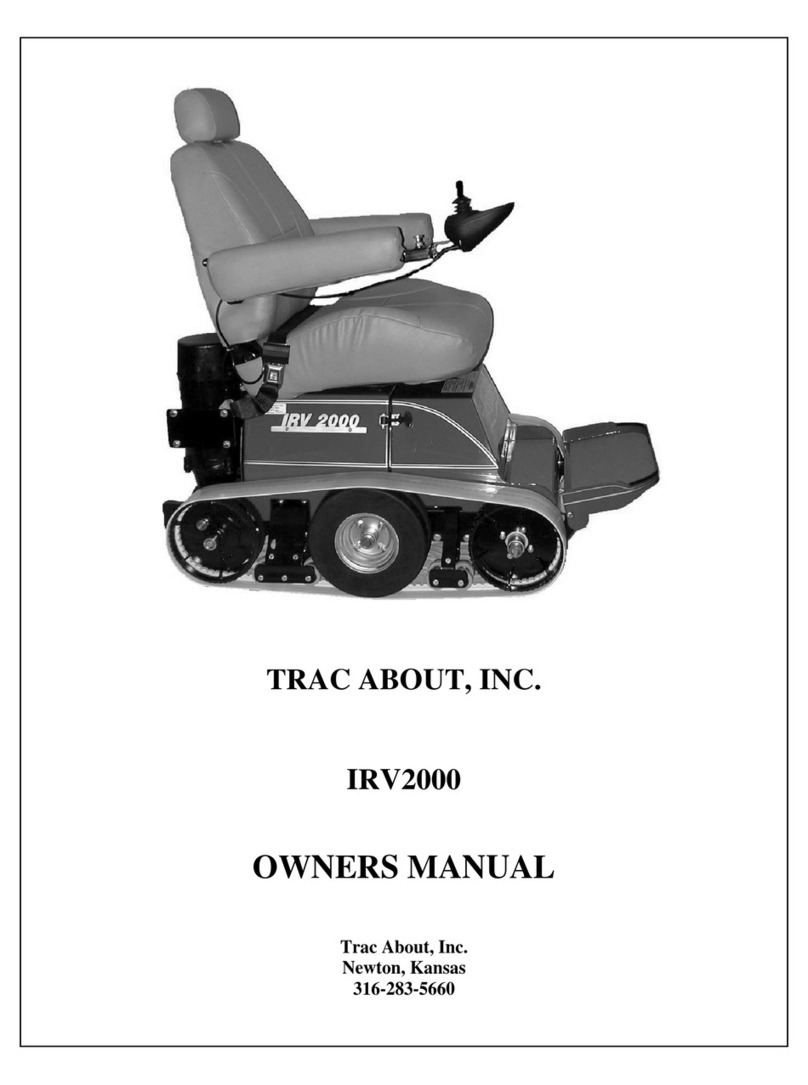
Trac About
Trac About IRV2000 owner's manual
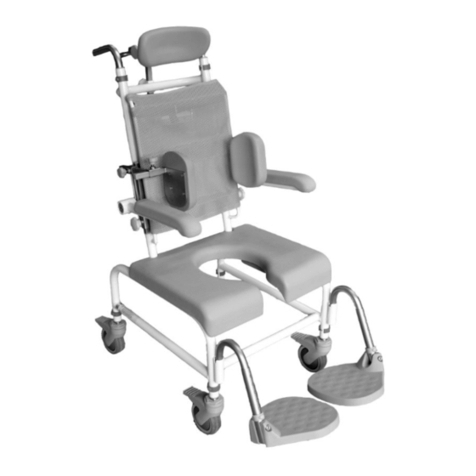
HMN
HMN M2 Mini Standard user guide

Amiga
Amiga TravelMate Owner operational manual

Platinum Health
Platinum Health PHB3300 Assembly and instruction manual
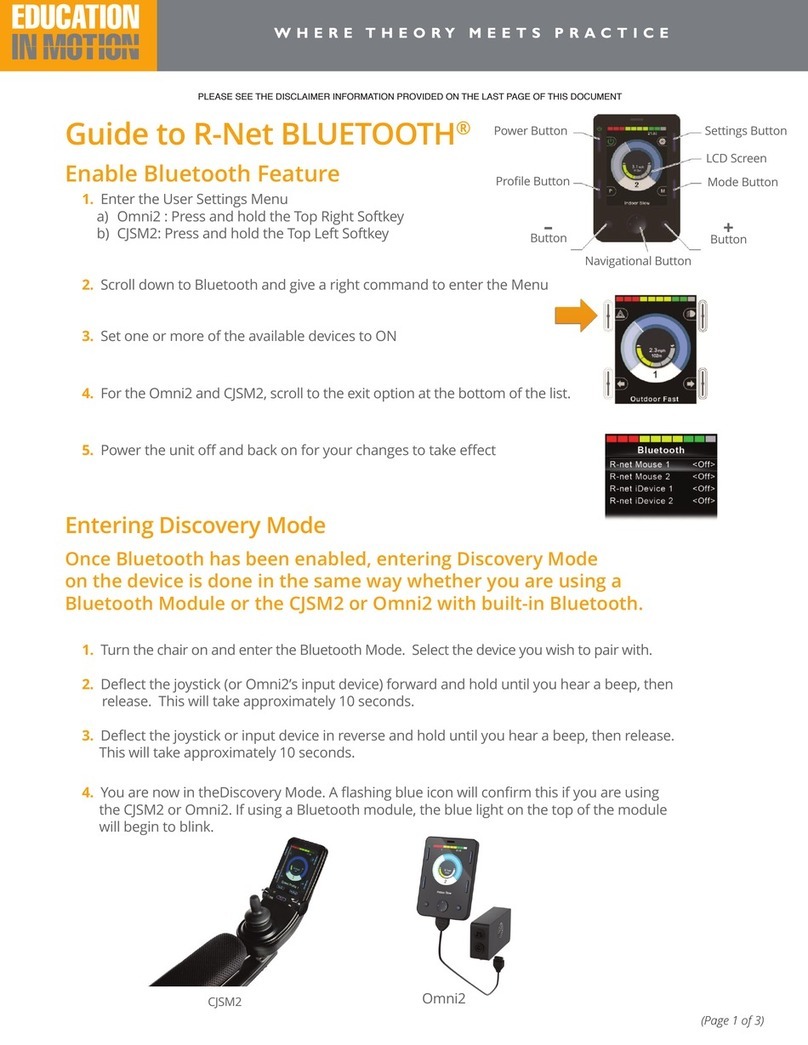
Sunrise Medical
Sunrise Medical R-Net BLUETOOTH Guide
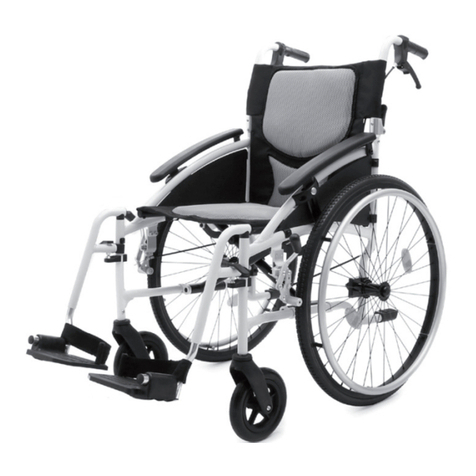
Orliman
Orliman actius ACWC05#41 Instructions for use and care

